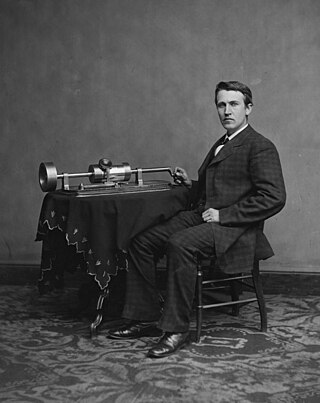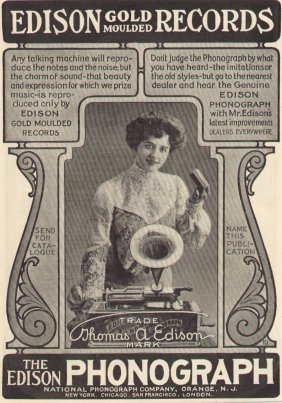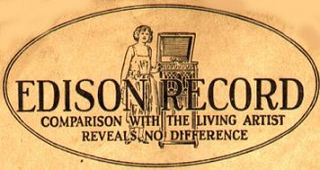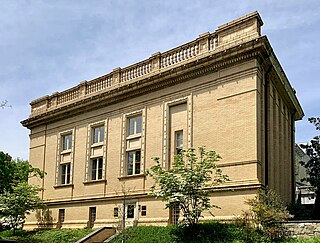
A phonograph, in its later forms also called a gramophone or since the 1940s called a record player, or more recently a turntable, is a device for the mechanical and analogue recording and reproduction of sound. The sound vibration waveforms are recorded as corresponding physical deviations of a spiral groove engraved, etched, incised, or impressed into the surface of a rotating cylinder or disc, called a "record". To recreate the sound, the surface is similarly rotated while a playback stylus traces the groove and is therefore vibrated by it, very faintly reproducing the recorded sound. In early acoustic phonographs, the stylus vibrated a diaphragm which produced sound waves which were coupled to the open air through a flaring horn, or directly to the listener's ears through stethoscope-type earphones.

Pathé Records was an international record company and label and producer of phonographs, based in France, and active from the 1890s through the 1930s.

Edison Records was one of the early record labels that pioneered sound recording and reproduction, and was an important player in the early recording industry.

The Edison Diamond Disc Record is a type of phonograph record marketed by Thomas A. Edison, Inc. on their Edison Record label from 1912 to 1929. They were named Diamond Discs because the matching Edison Disc Phonograph was fitted with a permanent conical diamond stylus for playing them. Diamond Discs were incompatible with lateral-groove disc record players, e.g. the Victor Victrola, the disposable steel needles of which would damage them while extracting hardly any sound. Uniquely, they are just under 1⁄4 in thick.

A laser turntable is a phonograph that plays standard LP records using laser beams as the pickup instead of using a stylus as in conventional turntables. Although these turntables use laser pickups, the same as Compact Disc players, the signal remains in the analog realm and is never digitized.

A magnetic cartridge, more commonly called a phonograph cartridge or phono cartridge or (colloquially) a pickup, is an electromechanical transducer that is used to play records on a turntable.
A format war is a competition between similar but mutually incompatible technical standards that compete for the same market, such as for data storage devices and recording formats for electronic media. It is often characterized by political and financial influence on content publishers by the developers of the technologies. Developing companies may be characterized as engaging in a format war if they actively oppose or avoid interoperable open-industry technical standards in favor of their own.

The overwhelming majority of records manufactured have been of certain sizes, playback speeds, and appearance. However, since the commercial adoption of the gramophone record, a wide variety of records have also been produced that do not fall into these categories, and they have served a variety of purposes.

Stereophonic sound, or more commonly stereo, is a method of sound reproduction that recreates a multi-directional, 3-dimensional audible perspective. This is usually achieved by using two independent audio channels through a configuration of two loudspeakers in such a way as to create the impression of sound heard from various directions, as in natural hearing.

RIAA equalization is a specification for the recording and playback of phonograph records, established by the Recording Industry Association of America (RIAA). The purposes of the equalization are to permit greater recording times, to improve sound quality, and to reduce the groove damage that would otherwise arise during playback.
Audio restoration is the process of removing imperfections from sound recordings. Audio restoration can be performed directly on the recording medium, or on a digital representation of the recording using a computer. Record restoration is a particular form of audio restoration that seeks to repair the sound of damaged gramophone records.
The history of sound recording - which has progressed in waves, driven by the invention and commercial introduction of new technologies — can be roughly divided into four main periods:

A dictation machine is a sound recording device most commonly used to record speech for playback or to be typed into print. It includes digital voice recorders and tape recorder.
In the field of audio recording, an aluminum disc is a phonograph record made of bare aluminum, a medium introduced in the late 1920s for making one-off recordings. Although sometimes used for making amateur studio or home recordings or in coin-operated "record-your-voice" booths at fairs and arcades, during the first half of the 1930s bare aluminum discs were primarily used to record radio broadcasts for the private transcription disc archives of performers or sponsors.
The AES coarse-groove calibration discs (AES-S001-064) are a boxed set of two identical discs, one for routine use, one for master reference. The intent is to characterize the reproduction chain for the mass transfer of coarse-groove records to digital media, much like using a photographic calibration reference in image work.

The Volta Laboratory and the Volta Bureau were created in Georgetown, Washington, D.C., by Alexander Graham Bell.(19/20th-century scientist and inventor best known for his work on the telephone)

Direct metal mastering (DMM) is an analog audio disc mastering technique jointly developed by two German companies, Telefunken-Decca (Teldec) and Georg Neumann GmbH, toward the end of the 20th century after having seen the same technology used by RCA Princeton Labs for its SelectaVision videodiscs in the late-1970s.

A disc cutting lathe is a device used to transfer an audio signal to the modulated spiral groove of a blank master disc for the production of phonograph records. Disc cutting lathes were also used to produce broadcast transcription discs and for direct-to-disc recording.
IRENE is a digital imaging technology designed to recover analog audio stored on fragile or deteriorating phonograph cylinders, records, and other grooved audio media. It is in use by several archives and preservation institutions in the United States seeking to preserve and digitize historical audio.
VisualAudio is a project that retrieves sound from a picture of a phonograph record. It originated from a partnership between the Swiss National Sound Archives and the School of Engineering and Architecture of Fribourg.













